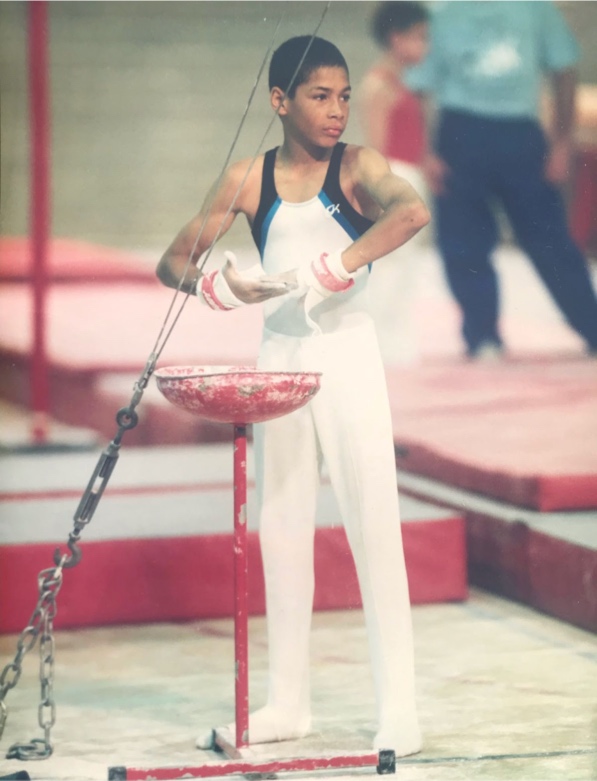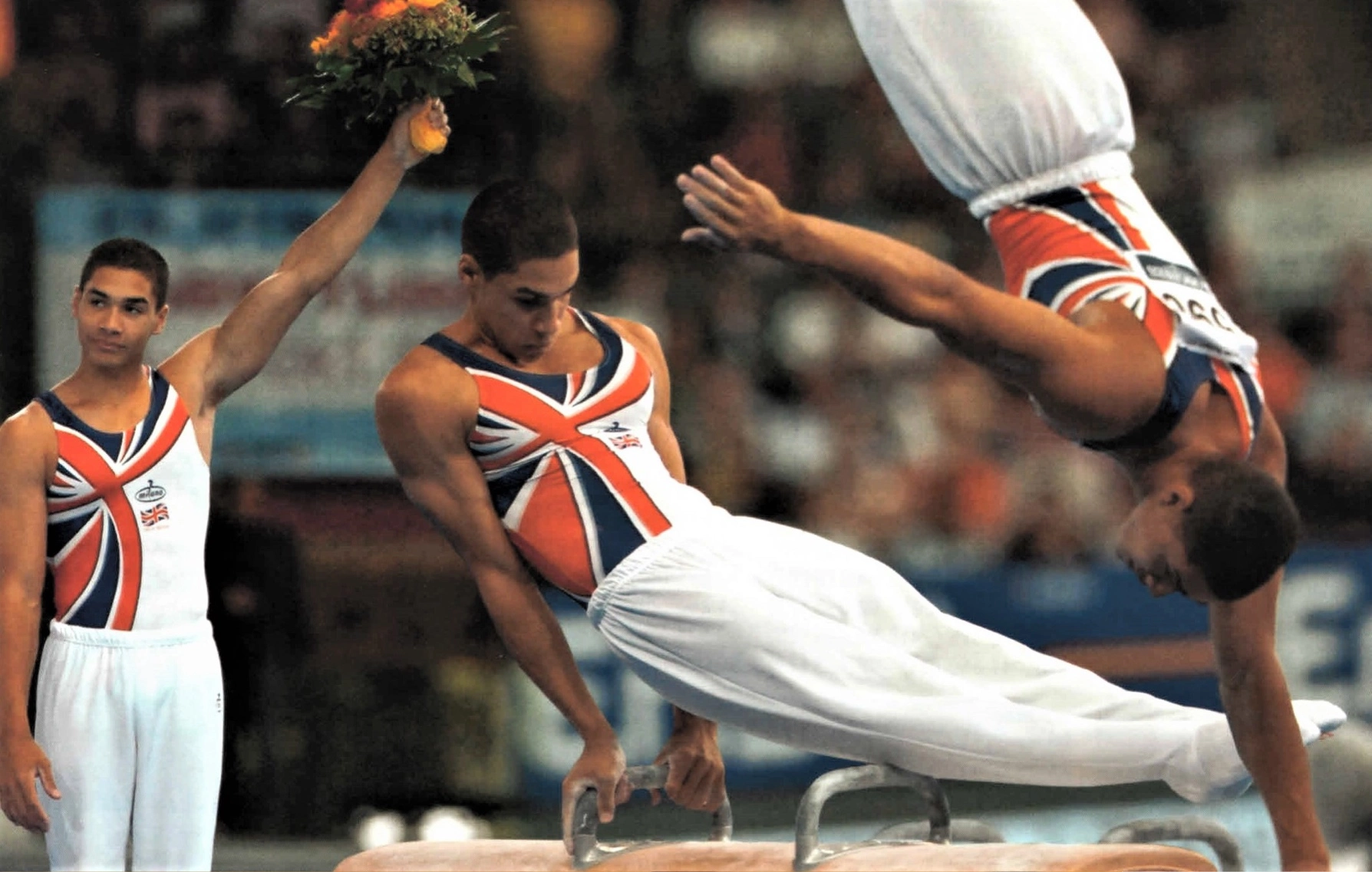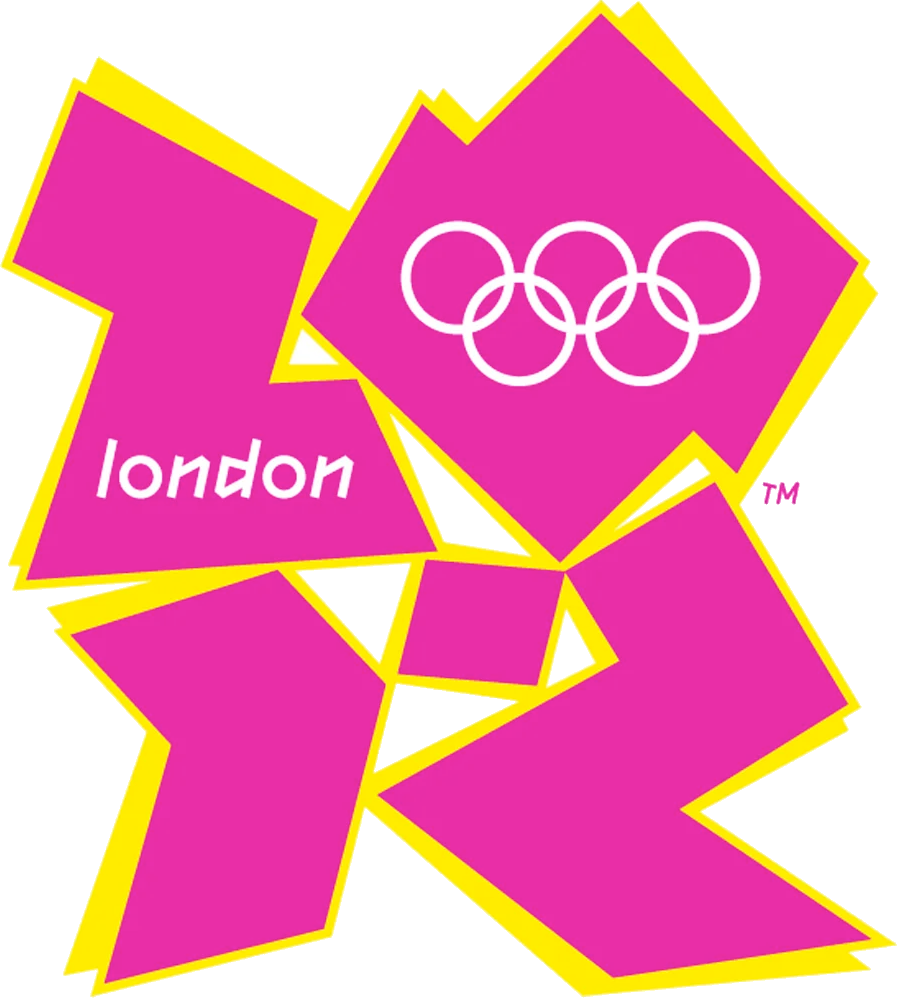Pommelling the opposition – how GB learned to ride the horse
Photo shows Paul Hall & Louis Smith at the Beijing Olympic Games in 2008 – credit Grace Chiu / British Gymnastics
I think that it was around the summer of 1996 when a gawky, long-limbed kid with dreadlocks ambled into the gym at Huntingdon, accompanied by his mum, who was in desperate need of an outlet for her son, who seemed to be wearing out the springs on her sofa at an alarming rate. Elaine was a nervous driver, having only recently passed her test, and had developed an aversion to turning right. The twenty-five-mile journey from Peterborough to the Olympic gym had taken well over an hour with the use of creative quadruple left turns in order to avoid said aversion, and Elaine arrived tired and exasperated.
‘I’m at my wit’s end. He spends all day somersaulting off the sofa and hanging off the door frames, please take him from me.’
Hmm, very little attention span, unfeasibly long arms, and an obvious naughty streak, but I thought it would be a challenge, so we took him on. I could never have predicted what Louis Smith would have achieved in those early days as he broke all the rules of selection around physical attributes; poor toes, long limbs, and an inability to get near any of the strength standards that I thought we were looking for. Indeed, in later years, he would always come near to last in the National testing, and I would have to fight to keep him on the Squad. This, coupled with his wandering mind and lack of concentration made him a challenge for the coaches, and always around if there was any mischief to be had.
Louis was, in fact, so naughty and found it so hard to concentrate that I found myself setting him constant challenges, just to keep him motivated and out of trouble. Often, this would involve heading to the pommel horse, the easiest and safest piece of apparatus to work under general supervision, and one that was sure to tire out most gymnasts that needed a channel for their boundless energy. This came at around the same time as I was forming my own gymnastics philosophy as a young, ambitious coach that had grown up on a diet of seeing GB regularly trounced in our sport by the Soviet machine, especially with their mastery of the pommel horse.
CLICK IMAGES TO VIEW FULL SIZE
Great Britain – mediocre on pommel horse
This was further compounded by the fact that in the 80’s and 90’s Great Britain was fairly mediocre on this piece of apparatus. I lost count of the number of times that I had watched our best gymnasts get unseated by the pommels and wondered what we were doing so wrong that made us so far behind the rest of Europe and the World, and resolved to improve. It couldn’t be that difficult to swing your legs and turn around a horse, surely not? All that was needed was a methodical approach and a great deal of practice, so I set about making a plan. At the same time, Louis was around 12 years old and had been to a meeting with National Coaches to discuss his targets.
‘So, what do you want to achieve in gymnastics, Louis?’
With no hesitation, the reply came back:
‘I’d like to win an Olympic Medal for GB.’
The National Coach and his assistant shared a look, paused for a second, and then burst out laughing. Years later Louis would tell me that that one meeting was by far the biggest factor in strengthening his resolve to go out and prove everybody wrong.
Paul’s little black book
We went back to the gym in Huntingdon and got down to work. I bought a little black book and a special watch that beeped at thirty-second intervals, and began a rigorous daily programme with a group of eight junior gymnasts. We began with a 30-minute session of thirty seconds on, thirty seconds off, half a minute of nonstop circling around a mushroom, followed by a similar amount of time to rest. The gymnasts got bonuses if they hit targets, and scores were recorded on a chart on the wall. We started with around 300 circles in 30 minutes, progressing each week to an increasing total as the gymnasts adapted to the workload and became ever more competitive in their groups and as individuals, hoping to top the chart on the wall. After a few months we progressed to 1000 circles in 45 minutes, close to 1 circle per second of work, interspersed with 30 seconds of rest. We did this twice a week, and trained pommels every day, working elements and perfecting technique on the non-endurance days.
At the same time, I was being advised by physios and other coaches that this volume would result in injury and poor performance. I was told that support work should be kept to a minimum and that training should be every other day and kept to a minimum due to the unique specificities of a sport that required an athlete to support their body on their arms. I thought the opposite and decided that a slow, gradual, and consistent increase in volume would ease adaptation and increase consistency in being able to stay on the apparatus.
Our most difficult apparatus had suddenly become easy!
The guys found it hard at first, and would complain about having sore wrists. We would always adapt the programme, avoid the pain by doing less repetitions if required, and working in different conditions that reduced the discomfort, but always trying to do something every day. After a few months, far from being injured or in pain, the gymnasts became more robust, adapted to the volume, and became far better at staying on the kit. We then developed individual and team competitions that allowed the gymnasts to do any skill that they wanted, giving bonus points for difficulty and extra-long combinations. This encouraged longer routines and motivated the group to do many combinations in an exciting and positive training environment. Our most difficult apparatus had suddenly become easy!
The Hundred Club
Louis was the master of all of these games, winning frequently and always finding ways to cheat the system with creative counting and clever combinations. The most coveted event was the most circles without stopping on the mushroom, a training device for teaching the basic swing around the body of the horse. We created ‘The Hundred Club’, an exclusive group of gymnasts who could circle the mushroom nonstop for that minimum amount. The Club record slowly grew to 130, 150, 170, until one day, at about 11 years old, Louis started circling and showed no signs of stopping- 200, 250, 300, the whole club urging him on to an almost impossible 336 circles. I then gave him the Code of Points, the manual for gymnastics elements, told him to look at the pictures and to try to do the skills. After a few weeks he had virtually completed every element in the book and I knew that all we had to do was put them all together.
Junior European Championships 2004
At the age of 15, Louis was selected for the 2004 Junior European Championships in Slovenia. We prepared by increasing the number of routines to up to five per day and twenty-five per week in the heavy loading phase of the build-up. At first, the routines would be inconsistent, with Louis falling regularly, but we persevered, and gradually the complex turns and travels became more consistent. In the month before the competition, I made another chart that required Louis to perform 50 clean routines, without falling, in order to board the plane to Ljubljana. This was a great deal more than any GB coach had contemplated in the past, but the build-up was gradual, and I knew that it was possible. As the weeks went by, I signed off on more and more exercises until, the day before travel, he had made 49 clean. We had an early flight the next day and agreed to come to the gym on the way to the airport to complete the plan- 50 routines ticked and we were ready!
The biggest afro in gymnastics history
One of the biggest challenges I had was to develop a belief that we could win. After so many years of falling, GB gymnasts were used to taking part and going home empty handed, but Louis never considered this and helped me to find the ability to dream big. In the qualification competition he performed one clean routine in the general warm up, another in the 3-minute warm up, and a third in the actual competition. He was completely nonchalant and had no plans to fall off after so many successful routines in the preparation. The final was a similar affair and Louis took the title with ease. In between winning and mounting the podium for the medal ceremony, he managed to undo his tightly braided hair to reveal the biggest afro in gymnastics history, leaving very little room on the rostrum for the other medallists.
Taking on the world
The following year, at just 16 years of age, Louis travelled to Melbourne for the World Championships, coming extremely close to making the final on pommel horse and gaining valuable experience from watching his idols in action. In 2006 he was back in Australia for the Commonwealth Games, and this time he was more prepared, taking gold and beginning an illustrious senior career that would see him fight for medals at the highest level of international competition. We continued to dream big and, along with clubmate Dan Keatings, set about the important task of building a reputation in Europe and beyond. Our target was always the Olympic Games, and we had set our sights on Beijing 2008.
Up until this point GB gymnastics had always gone to a Games to take part, having not won a medal since Walter Tysall shinned up a rope in 1908. Medals were for dreamers and were far out of reach of our British system, was the common belief. In 2007 we travelled to Stuttgart for the World Championships where three Huntingdon gymnasts: Louis, Dan, and Luke Folwell formed half of a six-man team that held the key to unlocking Olympic qualification places. The guys competed well, with Louis taking bronze on pommel and the Team gaining an important 15th place and two spots for GB to fill in Beijing next year. Louis and Dan continued a period of intense training and were finally rewarded with tickets to the 2008 Games.
Louis Smith at the World Championships in 2007 – photo Alan Edwards
Stealth mode
At just 19 years old, Louis crept in under the radar. No expectation, no hype, and no previous history of GB winning medals at this level, so he was relaxed and under no pressure to perform. At the qualification competition he performed his routine in front of over 12 thousand spectators in a packed arena as if he was doing one of the hundred of exercises that he had competed in the gym back home. He qualified for the final while Dan Keatings, so much the stylish all-round performer, missed one circle on one handle and finished ninth, just a tenth from joining his friend and having his own crack at Olympic glory. On the day of the final, I was quite nervous, but Louis appeared relaxed and was singing reggae to his iPod in the bus to the venue. Warm up went well and I nipped to the loo as the gymnasts prepared for march in to the Arena. I returned and could not find Louis anywhere. Seven gymnasts were in the line and the controller was calling for the final time, with no sign of the GB athlete. I was in a mild panic and searched the warm up gym for my missing gymnast. As I was leaning against the podium, a hand shot out from under the staging and grabbed my leg.
‘Surprise’ said Louis, with a big grin.
I jumped, and guided this crazy kid to the queue of gymnasts already marching out for the final at the Olympic Games, still grinning and pleased that he had managed to play a prank on his coach. Cool as the proverbial cucumber, he executed his complex routine, oblivious to the historic moment that saw him win GB gymnastics first Olympic medal in a century. The door was open, we could win at the highest level, and this special moment paved the way for many others to follow.
The catalyst for strong self belief
The medal in Beijing proved a great catalyst, and coaches and gymnasts followed Louis’ example, did the numbers, but now with a strong belief that winning was possible. So began our most successful period of world domination on the Pommel Horse. Junior European champions on this apparatus for over a decade, and an incredible boast that GB gymnasts have won over 50 percent of the available medals on pommels for the last 4 Olympic Games.
Post Script. So, what next.
Louis went on to win three more Olympic medals; two at 2012, the team bronze and a silver for pommels and then silver again in 2016. He is the first British gymnast to win multiple Olympic medals and the first to win 3 medals in a row at consecutive Olympics. Read more about the stories behind these medals in the 2012 & 2016 Olympic Games pages.
Louis was awarded the MBE in 2013. At the end of 2012, he entered and won Strictly Come Dancing and went on to feature and win in various shows on the TV, winning the Masked Dancer in 2021. He continues in show business. According to his mum Elaine, he loves dancing and singing.
Written by Paul Hall, 2022
Est. 2018 | © GymnasticsHistory.co.uk 2025












